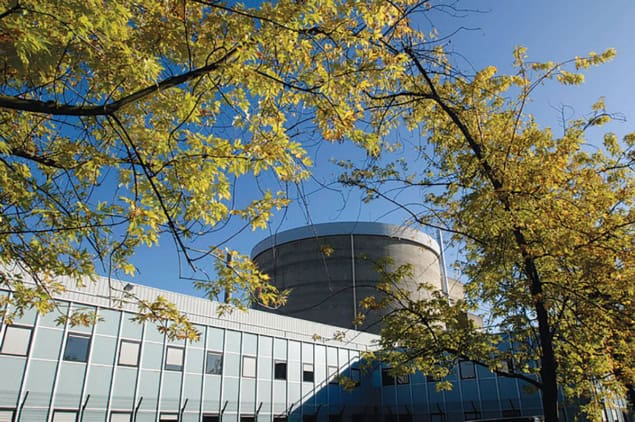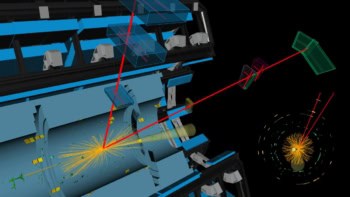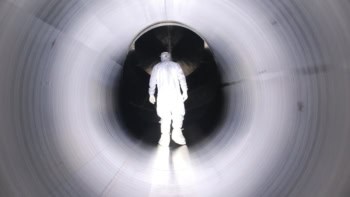As Europe’s neutron supply could fall by as much as half within the next couple of decades, newly developed sources could stave off the decline, as Jon Cartwright reports

There are good reasons to get excited by the €2bn European Spallation Source (ESS), which is currently under construction in Lund, Sweden. When the machine’s user programme finally starts in 2023, if all goes to plan, it will be the world’s most intense particle accelerator, generating up to 100 times more neutrons than any of today’s sources. Like a giant microscope, it will allow unprecedented studies into various fields – particularly the science of the everyday, such as plastics, pharmaceuticals, biological matter and nanotechnology. The ESS is a fitting tribute to Europe’s neutron research community, which is estimated to be by far the world’s largest, comprising some 6000 scientists and engineers.
Against this starry-eyed picture, however, a recent report published by the Neutron Landscape Group (NLG) makes for sobering reading, by pointing out that many sources are set to close within a decade. By the mid-2030s, according to the NLG, the best-case scenario is a 30% drop in neutron instrument time, while the worst-case scenario is a 60% reduction. In decades to come the ESS may be a transformative neutron source, but there may not be much of a neutron community left to use it. “The renewal of intermediate neutron sources becomes necessary to maintain a ‘critical mass’ for the neutron user community, otherwise new powerful sources such as the ESS become almost useless,” says Jacques Ollivier, a physicist at the Institut Laue-Langevin (ILL) in Grenoble, France. The ILL itself could close in 2023 unless its partners agree otherwise.
The renewal of intermediate neutron sources becomes necessary to maintain a ‘critical mass’ for the neutron user community, otherwise new powerful sources such as the ESS become almost useless
Jacques Ollivier, Institut Laue-Langevin
Fortunately, there may be ways to plug this neutron deficit. Physicists at the Forschungszentrum Jülich, in collaboration with those at the Laboratoire Léon Brillouin (LLB) in Saclay, France, are exploring the possibility of cheap, scalable neutron sources that could be installed at universities or at national facilities. The technology has already been put into practice outside Europe, for example at Indiana University in the US and at the Japan Collaboration on Accelerator-driven Neutron Sources – a nationwide network of researchers working on neutron-beam technologies and moderators. But the researchers at Jülich and the LLB want to push the technology to its limit, boosting the power output by at least a factor of 100.
Tailored solution
There are currently two main types of neutron source: spallation and reactor. In spallation, charged particles such as protons are accelerated into a heavy-metal target, kicking neutrons from the target’s nuclei. This process, which is employed at various facilities including the ISIS Neutron and Muon Source in Oxfordshire, UK, and which will also be employed at the ESS, is the most efficient, generating some 20 neutrons per incident proton. The second type of neutron source, the fission reactor, involves a single neutron splitting a uranium atom to generate three neutrons, which then split more uranium atoms, provoking a chain reaction. The ILL and the LLB are both reactor neutron sources.
For sociopolitical reasons, new research reactors are deemed unlikely to be built in Europe. But the chances of building further spallation sources in addition to the ESS are slim too – partly because big accelerators themselves are pricey, but also because the intense radiation requires huge amounts of shielding. The ESS’s inner monolith alone will comprise some 2000 tonnes of steel. “[Spallation] is a very efficient process, but it comes with a huge price tag,” says Thomas Brückel, director of the Jülich Centre for Neutron Science.
Brückel’s answer is a compact accelerator source, which accelerates protons or deuterons (bound protons and neutrons) to MeV rather than – in the case of the ESS – GeV energies. Such modest energies mean that the target must be made of a light metal, most likely beryllium. That in turn means a drop in efficiency, with an average of 10 incident protons or deuterons required to generate a single neutron. But the accelerator should be much cheaper and should produce far less unwanted radiation.
There are other benefits too. With less risk of radiation damage, the moderators (which reduce the energy of the emitted neutrons to a usable meV range) and the neutron optics (which guide the neutrons to the instruments) can be placed much closer to the target. That means several moderators can be squeezed around the target, each tailored to the needs of a specific instrument. In bigger spallation sources, where moderators have to be placed metres away from the target, the moderators have to be compromised to suit the needs of several instruments. “If you go to a shoe shop to buy some shoes, you do not buy size 50 so that they fit any feet – you buy shoes that fit your feet,” explains Brückel.
Consider this benefit, says Brückel, and suddenly this inefficient process becomes competitive. It is not better than current medium-flux sources, but he adds that it will be possible to build sources with dedicated beams for instruments “with a price tag that is much lower than what you have nowadays” – as little as €20m, about 100 times less than a new research reactor. “The beauty is that you can downscale it,” he notes.
Indeed, Brückel believes that the compact source could fit on one side of a football pitch, making it a viable prospect for universities as well as national facilities like ISIS. “At university, everybody has an electron microscope, everybody has an X-ray tube,” he says. “But normally university students can’t learn how to work with neutrons and professors can’t do challenging neutron experiments; they have to go to a large-scale facility. And this step, if you don’t have the experience, is huge.” The compact source could be just the ticket to foster the broader neutron community in the run up to the ESS and beyond.
To develop the technology, Brückel and his colleagues are working closely with Alain Menelle and others at the LLB. One of the greatest challenges, Menelle explains, is constructing the targets to produce neutrons effectively. “There are lots of [potential] solutions, [but] we can’t explore them all,” he says. There has already been interest from other institutions, he adds, including ESS-Bilbao in Spain, which is providing in-kind contributions to the ESS in Lund, and the Paul Scherrer Institut near Zürich, Switzerland. Once up and running, the compact neutron source ought to be able to perform neutron imaging, small-angle neutron scattering, powder and single-crystal diffraction, and perhaps other novel techniques; its limitation will be in the use of relatively large samples and an inability to reveal atomic dynamics (in contrast to the ESS).
Menelle’s group is hoping to have a low-flux demonstrator source ready for 2020, paving the way for the initial research version five years later, dubbed the Source compacte de neutrons s’Appuyant sur la technologie des accélérateurs (SONATE). Brückel’s group at the LLB is less ambitious on timescale, hoping to have its prototype ready for 2024 and the research version, the High Brilliance neutron Source (HBS), for 2030 or later. Neither SONATE nor the HBS will therefore plug the imminent deficit created by the closing medium-flux sources, but they could ease the loss – if it happens – of the ILL in the early 2020s.
Whether or not the ILL closes will come down to politics. Next year it will undergo an evaluation by its three major partners – France, the UK and Germany – and the 11 smaller national partners. Already it has undergone some €27m of safety improvements to protect the reactor from floods and other Fukushima-style disasters, but more funds will be needed to prolong its lifetime – cash that few partnered countries want to commit. Yet its loss would have a dramatic impact on the neutron community, making the new breed of sources like the HBS and SONATE all the more necessary.



